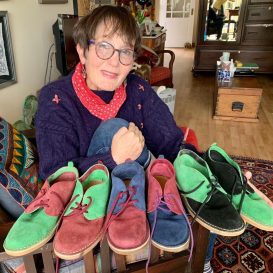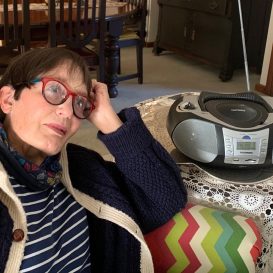 I was lying in bed last night thinking of Caleb Swanepoel. I wrote a blog on him. He is the young man whose leg was bitten off by a shark. I met him in George Medi-Clinic recently, whilst visiting Mum. The thought of him lying in bed with only one and a quarter legs was horrifying. If he needed a glass of water, he would have to grab his two crutches and….hold on! He can’t carry a glass of water and manoeuvre himself about on crutches. Glory, I didn’t think of that!
I was lying in bed last night thinking of Caleb Swanepoel. I wrote a blog on him. He is the young man whose leg was bitten off by a shark. I met him in George Medi-Clinic recently, whilst visiting Mum. The thought of him lying in bed with only one and a quarter legs was horrifying. If he needed a glass of water, he would have to grab his two crutches and….hold on! He can’t carry a glass of water and manoeuvre himself about on crutches. Glory, I didn’t think of that!
As my Dad would have said: Caleb “het ‘n lang en harde pad” (has a long and tough road) ahead of him! I give so much thanks for his loving, supportive family. Also for the fact that various people are setting about raising money that will be put towards his high tech, sophisticated prosthesis. But what about really poor people in a similar situation? People living in places like Uganda, Sudan or war torn Libya? Those countries are pockmarked with land mines and as a result their populations have been decimated and horribly maimed.
I remember earlier this year Carte Blanche, our investigative television documentary, had a feature about incredible “‘super-hero like” hands being produced for children born without these limbs – by means of 3D printing!

Yes, I know! You are looking at the page totally blankly, thinking: 3D printing! What the hell is Gaynor talking about?
The term ‘3D printing’ needs to be explained.
 3D printing (also know as additive manufacturing) is a process used to make a three-dimensional object without the use of dies, moulds or machining. In 3D printing, successive layers of material, usually plastic or special alloys, are laid down under computer control. These objects can be virtually any shape, and are produced from 3D photographs or digitised models. A 3D printer is basically a type of industrial robot. It is nothing to do with paper and ink!
3D printing (also know as additive manufacturing) is a process used to make a three-dimensional object without the use of dies, moulds or machining. In 3D printing, successive layers of material, usually plastic or special alloys, are laid down under computer control. These objects can be virtually any shape, and are produced from 3D photographs or digitised models. A 3D printer is basically a type of industrial robot. It is nothing to do with paper and ink!
Well it seems, a group of Canadians have now taken 3D printing a step further. In Uganda, they are using a 3D scanner and associated software to scan the ‘stumps’ of people needing prostheses. These images are then fed into the 3D printer. From the images the printer is able to produce a unique ‘stump’ socket mould for each individual. This can then be simply attached to a mass produced leg or arm.
 Before the adoption of 3D technology, the process of making prosthetic limbs was manual and unbelievably time-consuming. It involved wrapping plaster of paris around a plastic mould and waiting for it to dry and harden. This was then used as a negative mould to make a positive cast for the limb.
Before the adoption of 3D technology, the process of making prosthetic limbs was manual and unbelievably time-consuming. It involved wrapping plaster of paris around a plastic mould and waiting for it to dry and harden. This was then used as a negative mould to make a positive cast for the limb.
Patients had to wait at least two weeks before receiving their artificial limb, having to make several trips to the hospital during this time. Still the results were often ill-fitting sockets, which caused considerable discomfort.
Using 3D technology on the other hand, allows for a quick scan to digitise the ‘stump’. In less than a minute, the computer can capture a 3D image of the patient’s residual limb. This image can then be manipulated by the prosthetic technician and printing can begin!
The whole process takes just a few hours.
 In Uganda alone , there are only 12 prosthetic technicians for more than 250,000 people in need of prostheses. This problem can be significantly helped once 3D technology is made available across the country.
In Uganda alone , there are only 12 prosthetic technicians for more than 250,000 people in need of prostheses. This problem can be significantly helped once 3D technology is made available across the country.
With 3D produced protheses, these people have an opportunity to live a more normal life. This is an option that doesn’t take an age to accomplish. They can be given a whole new lease on living. This initiative could have huge potential, not only in Uganda, but in other developing countries where medical technology is still outdated. It will be interesting to see how this progresses in the coming years ahead.
I love this technological age that we live in. It is an era of Cochlear Implants, 3D prosthetics, bionic eyes, wheelchairs that are switch controlled. Technology, as we know it, that didn’t exist fifty years ago.
I smile at that!



















Thank you for the informative lesson, G. I’m 3D- printing up to speed…
Laugh – Jans, each week I learn something new in preparing this blog!
With a smile as always I kiss your eyes
Gaynor
Gaye, each Friday morning I learn something new, something significant, something heartwarming and something that takes the proverbial blinkers off my eyes from your blog. Thanks for showing me this and enlarging the world. With love.
Comments are closed.